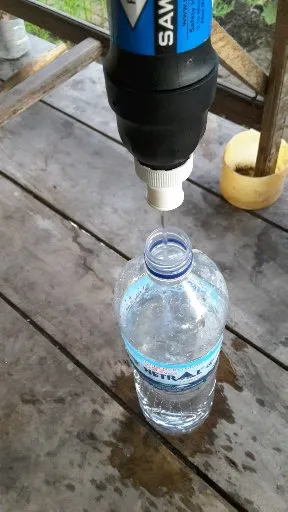Clean Water & Sanitation
 HAS installed the first running water and first toilet in Sili village, built a community toilet/bath house, and organized a fenced irrigated community garden on the clinic grounds to supplement villager’s diet.
HAS installed the first running water and first toilet in Sili village, built a community toilet/bath house, and organized a fenced irrigated community garden on the clinic grounds to supplement villager’s diet.
Generally, there is no running water in these villages. Drinking and bathing water comes from a handful of hand dug wells in the village centres. These are well made, stone with cement grout, with a cement apron to keep out surface ground water. The wells are busy meeting places all day long, where women do their washing and haul buckets of water to their home kitchens. Village wells provide reliable year-round water in some villages but water is scare in others. The people drink the well water without boiling or filtering, so the water is subject to contamination by parasites.
The goal is to improve access to clean drinking water within the communities we serve. Tactics include sharing information about the basics of water borne diseases and provide tools & techniques to manage water quality. HAS supports new well construction in strategic locations, water pumping & storage facilities, and provides long lasting water filters to eliminate bacteria & viruses from drinking water (such as Sawyer 0.10 micron hollow-fibre membrane filters).
Water quality is degraded by the fact that there are few toilets in this region. Villagers relieve themselves in the bush near their homes. The few toilets that do exist are frequently built too close to the well. Poor sanitation in general is a health issue. Flies move from faeces to food, spreading disease.
In 2017 HAS built the first public toilet / bathhouse on the clinic ground and will fund two farm toilets this year. Going forward we will provide the site evaluation, design and some materials to community groups which supply the labour. Septic Site planning is increasingly an important role for HAS. There is a tendency to build privies too close to wells because village homes are very close to one another.
Public Sanitation
HAS sponsors community toilet/bathing houses to be built by local volunteer labor. HAS provides the design, the cement, the toilet, the bricks, and the corrugated roofing. The appropriate technology is straightforward. Asian squat toilets are simple, low cost, familiar, proven technology which use little water (they flush with a dipper or two of water). The traditional showering system in Indonesia, like most of Southeast Asia, is to dipper water over one’s body from a pail, floor jar or tub. All that is required is a water tap in the bathroom wall.
Building the infrastructure is simple enough. The greater challenge is to change attitudes & behaviour. The idea that using a toilet is a lifestyle improvement must be successfully sold to members of the community. We expect this process will follow the typical pattern of new product/new technology introductions everywhere, where early adopters buy-in to the new facilities first, and others in the community follow over time.
